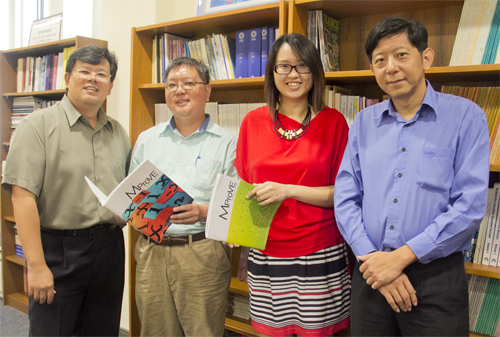Why Singapore’s English Teachers Should Embrace Singlish, Not Fight It
Is it time for Singaporean educators to embrace Singlish as a legitimate learning tool? What the Research […]
Read More
The learning of Math can be a challenge for some students. Sometimes, it is not because of the subject but rather, their attitude and disposition towards learning it.
So long-standing is Dr Leong Yew Hoong’s working relationship with Bukit View Secondary School that he is fondly known as Ah Leong by the teachers.
Eight years and counting of collaboration with the school has steered Yew Hoong’s research towards exploring effective Math teaching for Normal (Academic) (NA) students.
NA students are often seen to be slower learners compared to the Express cohort, although their Math curricula are similar. “Certain ways of teaching the Express students may not be workable for the NA students,” Yew Hoong notes. This motivated him to help them learn better.

(From left) Tong Cherng Luen, Clement Lee, Karen Toh and Leong Yew Hoong are working together to help students adopt a more positive attitude towards Math.
Bearing in mind the typical portrait of an NA student, Yew Hoong and his team, together with the teachers, conceptualized a framework of key learning objectives as part of the research project “Mathematical Progress and Value for Everyone (MProVE)”.
These objectives serve as the team’s reference points when addressing the NA students’ difficulties in learning Math. From there, they produced a set of teaching resources.
The ultimate aim of the resources is to inculcate positive learning traits in NA students, by incorporating the following objectives:
With these key learning objectives in mind, Yew Hoong’s team worked with teachers to redesign Math units. Each “replacement unit” incorporates at least one of the objectives mentioned above, but procedural fluency and disciplinarity of Math – which are considered particularly important – are always present.
What is perhaps noteworthy is how the replacement units are especially rich in learning objectives, but they take the same amount of time as those units they replace. This is because the NIE researchers know teachers could not possibly conjure up extra hours in lesson time.
Through the process of redesigning the curriculum, teachers stumbled upon an interesting concept they dubbed “making thinking visible”.
When working on Math problems, teachers ask students to pen their reasons for solving a problem in a particular way in a column next to the questions. The teachers soon discovered that this was helpful not for just one topic, but a few topics across the board.
Yew Hoong explains, “That is the real intention of our project. It is not just about teaching this one topic better, but it is also hoped that by planning this number of replacement units, some of these skills are transferrable to other units which we did not plan.”
In fact, such practices can be adapted for other subjects, and not just Math, says Yew Hoong.
We hope to see our students not shirking away, but engaging with the problem without necessarily having to solve it completely
– Leong Yew Hoong, Mathematics and Mathematics Education Academic Group
After a few rounds of tweaking, two Math units were finalized and published as print resources with CD-ROMs, while a few other units are in different stages of being refined.
More than just a project to enhance teaching and learning materials, Yew Hoong’s work also serves to develop the teachers professionally.
Although the resources are free for dissemination among teachers, they “are not meant to be used without teacher development”. He emphasized how there is much more to the successful implementation of such materials.
For example, the researchers video-recorded teachers as they implemented the replacement units in class. Taking into account the teachers’ hectic schedules, the research team condensed 6 hours’ worth of recording into 30-minute video summaries for the teachers’ viewing.
A post-mortem discussion is conducted after each unit. Each teacher would point out interesting observations they gleaned from the video summaries, leading to further dialogue on improvements.
This kind of researcher-teacher partnership kills two birds with one stone: It develops teachers professionally, and creates an end product that is refined and proven to be effective.
Yew Hoong urges teachers who may be interested in this project to contact him, as he will be more than happy to work with them to help their Math learners.